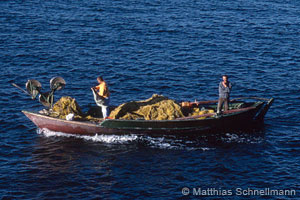 The FAO’s General Fisheries Commission for the Mediterranean (GFCM) adopted a series of recommendations aimed at protecting monk seals from accidental entanglement in fishing gear at its 9-14 May 2011 session in Rome.
The FAO’s General Fisheries Commission for the Mediterranean (GFCM) adopted a series of recommendations aimed at protecting monk seals from accidental entanglement in fishing gear at its 9-14 May 2011 session in Rome.
Recommendation GFCM/35/2011/5 on Fisheries Measures for the Conservation of the Mediterranean Monk Seal (Monachus monachus) in the GFCM Competence Area calls for Contracting Parties and Cooperating Parties of the Commission (CPCs) to implement the following measures:
— Prohibit fishing vessels from taking on board, transporting or landing monk seals unless required to assist in the rescue of injured individuals, and only then with prior official authorisation.
— Seals encountered entangled in fishing gear must be released unharmed and alive.
— Seals found dead in fishing gear must be brought ashore and the authorities promptly notified (at the latest upon arrival at port).
— Any incidental take and release must be recorded in the vessel’s logbook, and reported to the relevant authorities for onward notification of the GFCM Secretariat.
— No later than 2015, CPCs should adopt fisheries management measures designed to attain a “very low and close to 0 risk” of incidental take and mortality of monk seals in fishing activities.
— CPCs must provide the GFCM Secretariat with the geographical positions of already known, past and current monk seal caves, with corresponding information on fleets deploying bottom-set nets within a maximum 20 mile range. Preliminary maps and data should be completed by December 2011, and transmitted to the GFCM no later than 31 January 2012. (Access to such potentially sensitive data, the document is at pains to point out, will be restricted.)
The recommendations list also includes unspecified research to test the efficacy and socio-economic impact of the implemented measures, as well as characteristically vague proposals to “promote participatory programmes with relevant stakeholders.”
Though presenting several robust actions to address what is one of the most critical mortality factors affecting the species, the recommendations spell something of a retreat from those advocated by the GFCM’s own Scientific Advisory Committee, which included the following specific proposal at its 7-11 February 2011 Marseille meeting:
— To reduce monk seal by-catch, restrict the setting of static nets in a belt comprising a minimum of 5 nautical miles radius around the location of monk seal caves along autumn and winter, [sic] extended to 10 miles around breeding caves. The restriction should be linked to gear adaptation support measures to artisanal fishers in need of it.
Greek monk seal conservation NGO MOm lobbied vigorously against that measure in the belief that, if enacted, it would sour already difficult relations with coastal fisheries, and increase hostility towards the monk seal. It suggested that the measure would have a “catastrophic” impact both on the survival of the monk seal and local fishing communities. Direct killing remains the most serious mortality factor affecting the species in Greek waters.
Protecting important monk seal birthing caves during the pupping season has appeared in conservation action plans going back to the 1970s, and one is left to speculate whether it was the vague wording of the SAC proposal — seeming to target all monk seal breeding caves, everywhere, rather than those identified as a conservation priority — that incited the greatest objection.
MOm, however, also emphasised the results of its own research suggesting that naive juveniles, rather than pups, are the ones most likely to become entangled in fishing nets [Mediterranean monk seal mortality in 2010 in Greece].
However, lethal entanglement of monk seal pups has been a serious concern elsewhere, for example in the Foça Specially Protected Area, Turkey, where an entire generation of pups was wiped out as a result of coastal fishermen being permitted to set nets in the vicinity of monk seal breeding caves [Snared and Drowned].
While several conservation organisations have applauded the GFCM recommendations, it remains to be seen whether any of them will actually see the light of day.
Further information
GFCM. 2011. Report of the thirty-fifth session. General Fisheries Commission for the Mediterranean, FAO Headquarters, Rome, 9-14 May 2011: 1-161. [PDF]
GFCM. 2011. Draft report of the 11th session of the Sub-committee on Marine Environment and Ecosystems (SCMEE). Scientific Advisory Committee (SAC) Thirteenth Session. General Fisheries Commission for the Mediterranean, Marseille, France, 7-11 February 2011: 1-63. [PDF]
